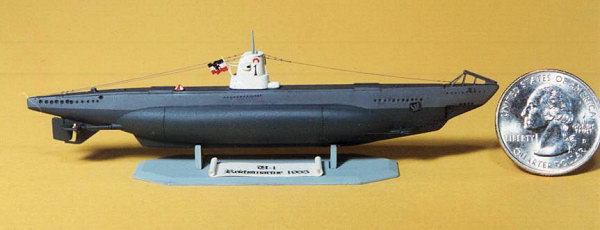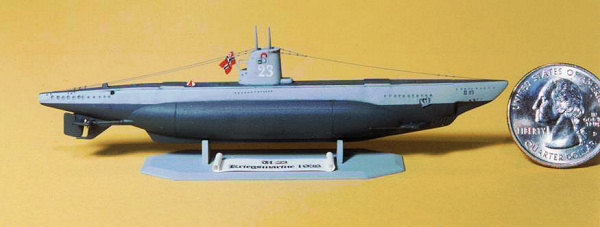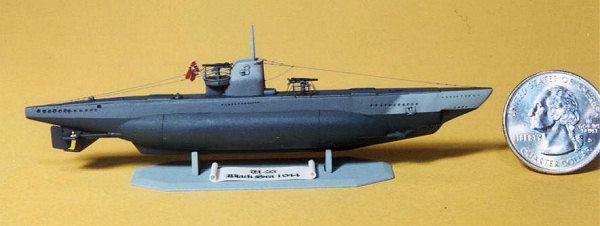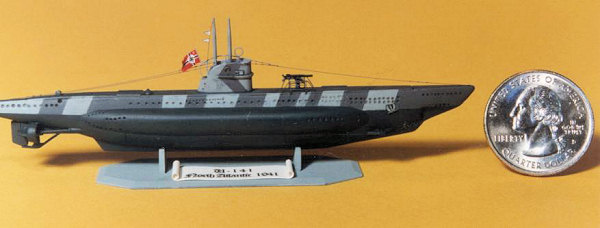
| KIT: | Mirage 1/400 Type II A/B/C/D U-boats |
| KIT #: | 40023/4/5/6 |
| PRICE: | $6.98 MSRP each |
| DECALS: | Several Options |
| REVIEWER: | Tim Reynaga |
| NOTES: |

| HISTORY |
Nicknamed Einbaume, or “dugout canoes” because of their small size, the Type II coastal U-boats were the first submarine designs built by Germany as she rearmed following the First World War. The Type IIs were produced in four basic subtypes, known as Types IIA, IIB, IIC, and IID. Each subtype represented a modest development of the basic design incorporating changes in the tower, deck armament, etc. All had similar appearance and performance except the final Type IID with its slightly redesigned hull. These small boats embarked a crew of 23 men and carried a mere five torpedoes.
Despite their limited offensive capabilities, the Type II boats served the German navy faithfully from the mid 1930s through the end of World War II. Initially intended for coastal operations in the Baltic to protect the iron ore sea routes to Sweden, they were also employed in the Atlantic and the Black Sea as well as forming the backbone of the U-boat training schools. As second-rate combat subs and training boats the diminutive Type IIs were moderately successful, but they have always been overshadowed by their larger, more famous brethren.
 U-1
(Type IIA)
U-1
(Type IIA)
The U-1 was the very first U-boat of the Ubootwaffe, commissioned in 1935 just after Germany renounced the Versailles Treaty. She made two patrols during the war but achieved no successes. The boat was lost with all hands off Norway after hitting a British mine in March, 1940.
U-23 (Type IIB)
Commissioned in 1936, U-23 was one of twenty Type IIBs, the most numerous Type II variant. In 16 war patrols she sank a total of 7 ships including two warships, as well as damaging two others. After service in the Atlantic, U-23 served with the 21st Unterseebootsschulflottille (U-boat School Flotilla) from July, 1940 until September, 1942. U-23 was then stripped down to just the hull, transported by barge and road vehicle to be reassembled at the port of Constanza, Romania. There she served with with the 30th Flotilla in the Black Sea against the Soviets. U-23 operated there until scuttled by her crew on September 10, 1944 off the coast of Turkey to prevent capture by the advancing Red Army.
U-141 (Type IID)
Commissioned just after the start of the war, U-141 served most of her career as a training boat with the exception of four patrols in the Atlantic between May and September 1941 during which she sank four ships and damaged another. Returning to training duties for the remainder of the war, U-141 was ultimately scuttled on May 2, 1945 at Wilhelmshaven.
| THE KIT |

U-1 (Type IIA) kit #40023
U-23 (Type IIB) kit #40024
U-60 (Type IIC) kit #40025
U-149 (Type IID) kit #40026
 A while back
Mirage Hobby of Poland released the first of their line of Kriegsmarine
subs, the Coastal Types IIA, IIB, IIC, and IID. Even though they were in the
less popular (at least in the U.S.) scale of 1/400, I was still very pleased
because the Type IIs had not been available previously in injection molded
plastic. They assemble quickly into attractive little 4 inch long models, and
for less than $7 each they are very affordable.
A while back
Mirage Hobby of Poland released the first of their line of Kriegsmarine
subs, the Coastal Types IIA, IIB, IIC, and IID. Even though they were in the
less popular (at least in the U.S.) scale of 1/400, I was still very pleased
because the Type IIs had not been available previously in injection molded
plastic. They assemble quickly into attractive little 4 inch long models, and
for less than $7 each they are very affordable.
The hull shapes are basically accurate, with the conning towers and decals especially well done. The Types IIA, IIB, and IIC have, like the prototypes, the same basic hulls with superstructure and weapons differences. The plastic in all those kits is the same with alternate conning tower and weapons parts. I was impressed that Mirage Hobby didn’t succumb to the temptation to reuse the earlier hull on the Type IID to save tooling costs; it was a noticeably different shape, and they nailed it pretty well. Also, the decals were outstanding with full markings for two boats in each kit including petite crests and naval ensigns.
The faint plank detailing of the decks and the rather crude renditions of the drainage openings in the hull sides were a little disappointing. The drainage vents are only depicted by indistinct dimples on the hull sides, and they aren’t even in line. These could be fixed of course, but it would be a major job requiring filling in and reopening the dozens of tiny oval holes on four different boats. Mirage has since released separate photo etch upgrade sets for their Type IIs which include hull panels with the corrected limber holes. These sets are very nice, but you have to buy them separately to fix something Mirage really should have done right the first time!
| CONSTRUCTION |
 I liked
these little kits very much, but with those limber hole problems I decided to
build them all more or less straight out of the box.
I liked
these little kits very much, but with those limber hole problems I decided to
build them all more or less straight out of the box.
The first model was the U-2 (Type IIA). I used the alternate decals provided in the kit to build it up as U-1. The only modifications were to add safety rails on the conning tower with copper wire, wire supports for the net cutter, and ultrathin copper wire rigging. I also tossed the crude kit anchor and replaced it with a Tom’s Modelworks photoetch brass part. U-1 is depicted as she appeared shortly after commissioning in 1935 with the dramatic white conning tower over dark gray (Testors RAF Ocean Gray) hull and darker gray (Testors European 1 Gray) underwater hull with a white and red rescue buoy on the deck. U-1 also sports the very cool black/white/red Reichsmarine naval ensign provided in the decal sheet.
The U-23 (Type IIB) is depicted in basic prewar gray as she appeared in 1938 when commanded by Kapitänleutnant Otto Kretschmer, who later went on to become the top scoring U-boat ace. The construction was similar to the U-1 except for the Hellgrau (Testors Light Ghost Gray) color and Kriegsmarine battle ensign.
 Instead of
building the Type IIC as U-60, which was virtually identical in appearance to
the Type IIB U-23, I built it up as U-23 as she appeared during her Romanian
deployment to show how the appearance of that boat evolved over time. By 1944
U-23 was refit with two 20mm deck guns and a small platform abaft the conning
tower, and she wore the distinctive two-tone graded camouflage typical of Black
Sea boats. The guns and platform were from the kit, the railings were Eduard
1/400 photoetch brass parts.
Instead of
building the Type IIC as U-60, which was virtually identical in appearance to
the Type IIB U-23, I built it up as U-23 as she appeared during her Romanian
deployment to show how the appearance of that boat evolved over time. By 1944
U-23 was refit with two 20mm deck guns and a small platform abaft the conning
tower, and she wore the distinctive two-tone graded camouflage typical of Black
Sea boats. The guns and platform were from the kit, the railings were Eduard
1/400 photoetch brass parts.
The U-141 (Type IID) was built similarly to the others, with a few wire rails and rigging as well as photoetch rails for the deck. The colors are those she wore during her 1941 North Atlantic deployment, with dark gray (Testors RAF Ocean Gray) stripes over light gray (Testors Dark Ghost Gray) camouflage and a Testors European 1 Gray underwater hull.
| CONCLUSIONS |
It is nice to see a model manufacturer release something a little out of the ordinary, and the humble Type II U-boats certainly fit the bill. These little guys were a kick to build. Yeah, they’ve got problems, but when was the last time you had this much fun for less than seven bucks?
March 2007
| REFERENCES |
U-Boat War Timothy j. Kutta, Squadron/Signal Publications, Texas, 1998.
U-Boats in Action Robert C. Stern, Squadron/Signal Publications, Texas, 1977.
If you would like your product reviewed fairly and quickly by a site that has over 350,000 visits a month, please contact me or see other details in the Note to Contributors.